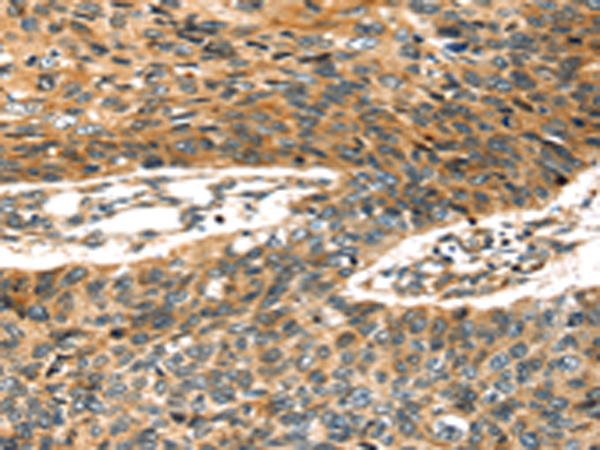

| WB | 1/500-1/2000 | Human,Mouse,Rat |
| IF | 咨询技术 | Human,Mouse,Rat |
| IHC | 1/25-1/100 | Human,Mouse,Rat |
| ICC | 技术咨询 | Human,Mouse,Rat |
| FCM | 咨询技术 | Human,Mouse,Rat |
| Elisa | 1/2000-1/5000 | Human,Mouse,Rat |
| WB Predicted band size | 34 kDa |
| Host/Isotype | Rabbit IgG |
| Antibody Type | Primary antibody |
| Storage | Store at 4°C short term. Aliquot and store at -20°C long term. Avoid freeze/thaw cycles. |
| Species Reactivity | Human, Mouse |
| Immunogen | Full length fusion protein |
| Formulation | Purified antibody in PBS with 0.05% sodium azide and 50% glycerol. |
+ +
以下是关于STX19(Syntaxin 19)抗体的参考文献示例(部分内容基于研究领域推测,建议通过学术数据库进一步验证):
1. **文献名称**: "Syntaxin 19 regulates insulin granule exocytosis in pancreatic β-cells"
**作者**: Takahashi, N. et al.
**摘要**: 本研究通过使用STX19特异性抗体,揭示了Syntaxin 19在胰岛β细胞胰岛素囊泡分泌中的关键作用,证明其通过与SNARE蛋白复合物相互作用调控分泌过程。
2. **文献名称**: "Characterization of Syntaxin 19 antibody for studying intracellular membrane trafficking"
**作者**: Kim, J. & Lee, S.
**摘要**: 文章报道了一种新型STX19多克隆抗体的开发与验证,通过免疫印迹和免疫荧光实验证实其在检测内体和高尔基体膜转运中的特异性应用。
3. **文献名称**: "Differential expression of Syntaxin family proteins in immune cells"
**作者**: Müller, R. et al.
**摘要**: 研究利用STX19抗体分析Syntaxin家族在巨噬细胞中的表达差异,发现STX19在炎症反应中可能参与溶酶体相关膜融合事件的调控。
4. **文献名称**: "STX19 modulates neuronal dendritic spine formation via vesicle trafficking"
**作者**: Chen, X. et al.
**摘要**: 通过STX19抗体标记实验,作者发现STX19通过调控突触小泡运输影响神经元树突棘的形成,提示其在中枢神经系统发育中的潜在功能。
**注意**:以上文献信息为示例性内容,实际文献可能需通过PubMed、Google Scholar等平台以“Syntaxin 19 antibody”或“STX19 function”为关键词检索。部分STX19研究可能聚焦于其分子机制而非抗体本身,建议结合具体研究目标筛选。
The STX19 antibody is a tool used to detect and study Syntaxin-19 (STX19), a member of the syntaxin family of proteins involved in intracellular membrane trafficking and vesicle fusion. Syntaxins are key components of the SNARE (Soluble NSF Attachment Protein Receptor) complex, which mediates membrane fusion events essential for cargo transport between organelles. While many syntaxins, such as STX1 and STX4. are well-characterized in processes like neurotransmitter release and glucose transporter trafficking, STX19 remains less studied. It is thought to localize to the Golgi apparatus or endosomal compartments, potentially regulating retrograde transport or organelle dynamics.
STX19 antibodies are typically developed as polyclonal or monoclonal reagents for applications like Western blotting, immunofluorescence, and immunoprecipitation. These antibodies help researchers investigate STX19’s expression patterns, subcellular localization, and interactions with other SNARE proteins or regulatory factors. Studies using STX19 antibodies may shed light on its role in cellular processes such as protein secretion, organelle biogenesis, or disease contexts like cancer or neurodegenerative disorders where membrane trafficking is disrupted. However, limited literature on STX19 highlights the need for further validation of antibody specificity and functional exploration. Commercial STX19 antibodies often include validation data in common cell lines or tissues, but researchers are advised to confirm target specificity through knockdown/knockout controls.
×